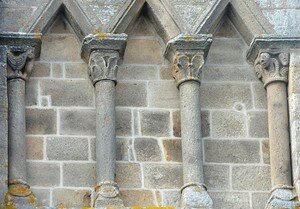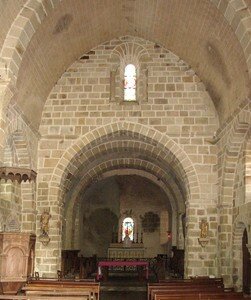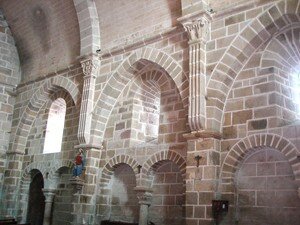Church of the Holy Trinity in Autry-Issard
 Autry-Issard
belongs to the way of Saint-Jacob in Bourbonnais, which was
reconsidered little time ago. A layout was established according to
thorough research and was elaborate in order to propose to the pilgrim
of the way of Jacques Saint in Bourbonnais the greatest number of
reference marks jacquaires, of strong points of the Romanesque art, a
relatively right line and an intact rural landscape, as well as
possibilities of lodging. It is difficult to find the true way, but the
following list surely approaches some:
Autry-Issard
belongs to the way of Saint-Jacob in Bourbonnais, which was
reconsidered little time ago. A layout was established according to
thorough research and was elaborate in order to propose to the pilgrim
of the way of Jacques Saint in Bourbonnais the greatest number of
reference marks jacquaires, of strong points of the Romanesque art, a
relatively right line and an intact rural landscape, as well as
possibilities of lodging. It is difficult to find the true way, but the
following list surely approaches some:
 1) Veurdre - Agonges (while passing by St Léopardin d' Augy, Aubigny, Bagneux)
1) Veurdre - Agonges (while passing by St Léopardin d' Augy, Aubigny, Bagneux)
2) Agonges - Souvigny (St Menoux, Autry-Issard)
3) Souvigny - Châtel de Neuvre (Coulandon, Besson, Chemilly)
4)
Châtel de Neuvre - Chantelle (Monetay S. Allier, Contigny, Verneuil,
Saulcet, Louchy-Montfond, Cesset, Fleuriel, Deneuille Chantelle)
5) Chantelle - Ebreuil (Taxat-Senate, Charroux, St Bonnet of Rochefort, Vicq, Ebreuil)
 The layout continues in Puy de Dôme while passing by Combronde and Mozac/Riom, to arrive to Clermont-Ferrand.
The layout continues in Puy de Dôme while passing by Combronde and Mozac/Riom, to arrive to Clermont-Ferrand.
It is refers to Autry-Issard of discovered into 1909 of a virgin in majesty in bad condition in the apse of the priory of Saint-Maurice, who would be probably a former black virgin.
 The
sanctuary of Autry-Issard is capped with a turn-bell-tower square with
two érages which is one of most beautiful of Bourbonnais. The
auvergnate influence is obvious here.
The
sanctuary of Autry-Issard is capped with a turn-bell-tower square with
two érages which is one of most beautiful of Bourbonnais. The
auvergnate influence is obvious here.
The gate
 The
principal door, in semicircular arch, opens in a fore-part of masonry
to two remapants. it is crimped of a continuous roll and an archivolt
with billet related to monolithic columns.
The
principal door, in semicircular arch, opens in a fore-part of masonry
to two remapants. it is crimped of a continuous roll and an archivolt
with billet related to monolithic columns.
Two broad grooved
pilasters accost it, with the capitals decorated with rinceaux and
birds drinking with the same chalice. The lintel as a bâtière, resting
on two columns imbedded in the amounts, represents an almond glory
bordered of pearls, containing a Christ formerly blessing, and
supported by two archangels, Michel and Raphaël. On each side lamps
under arcades at bottom of checkerworks and overlaps hang.
 A
small platform in the shape of arc in mitre shelters glory. One reads
there inscription “PENAS REDDO PRAEMIA THUS PROFITS”, recalling that
Christ is a also judge and sovereign. One reads also the names of the
archangels, and on the lintel: “CUNCTA DEUS FECI HOMO FACTUS CUNCTA
REFECTI”, a sentence which underlines the identity of divine work and
that of deiu makes man, with, remarkable characteristic, the signature
of the artist: “NATALIS ME FE (CIT)”, Christmas made me.
A
small platform in the shape of arc in mitre shelters glory. One reads
there inscription “PENAS REDDO PRAEMIA THUS PROFITS”, recalling that
Christ is a also judge and sovereign. One reads also the names of the
archangels, and on the lintel: “CUNCTA DEUS FECI HOMO FACTUS CUNCTA
REFECTI”, a sentence which underlines the identity of divine work and
that of deiu makes man, with, remarkable characteristic, the signature
of the artist: “NATALIS ME FE (CIT)”, Christmas made me.
The primitive table
 This
painting of the Flemish school of the end of XVème century is a votive
table, as certain families liked to offer some to their parish church.
According to the use of time, it is a Deposition which appears in the
center of the scene. One finds there on the right Saint Jean and on the
left Marie-madeleine. A giver is behind Saint Jean, follow-up of his
daughter and his wife, and on the left, the second donnator followed by
his wife and his four children. One is unaware of still the name of the
painter and those of the donnateurs.
This
painting of the Flemish school of the end of XVème century is a votive
table, as certain families liked to offer some to their parish church.
According to the use of time, it is a Deposition which appears in the
center of the scene. One finds there on the right Saint Jean and on the
left Marie-madeleine. A giver is behind Saint Jean, follow-up of his
daughter and his wife, and on the left, the second donnator followed by
his wife and his four children. One is unaware of still the name of the
painter and those of the donnateurs.
Capitals
 They
are very speaking, and one finds the expensive topics with the imagiers
of the Middle Ages: two birds drinking with the same chalice, human
figures leaving rinceaux, geometrical figures formed by the foliages.
All this teach us the symbolic system, and shows us how energies pass
in the church.
They
are very speaking, and one finds the expensive topics with the imagiers
of the Middle Ages: two birds drinking with the same chalice, human
figures leaving rinceaux, geometrical figures formed by the foliages.
All this teach us the symbolic system, and shows us how energies pass
in the church. 
The furnace bridge
 It with the characteristic to represent Moïse with horns.
It with the characteristic to represent Moïse with horns.
“The
comments and other studies often explain why all this idea of horns is
exclusively related to a bad interpretation of the Hebrew text. But
this is not really sure. It seems to to me, on the contrary, that the
Hebrew account exploits ambiguity: the verb “qaran” can indeed mean “to
radiate” or “to be horned”. Thus for a Hebrew listener the two
significances mix.
The sensitivity to this ambiguity is found in particular at Marc Chagall, who presents the “horns” of Moïse like luminous rays. The horns symbolize the force and are often divine attributes. But in the context of the account of golden calf, there is perhaps a direction even major. The people wanted a god visible; by doing this it caused the “original transgression of Israel” and the destruction of this image. At the time of renewed alliance, Moïse appears with “horns”.
Did it take the place of the bull? In a certain way, it is the case, since it is, him, the visible mediator between Yahvé and Israel. It is certainly not the representation of God of Israel, but it remains definitively its best representing. Thus, the horns express the completely particular statute of Moïse. By doing this, the author of Ex 34,29 fact proof of a great audacity since it transposes of the attributes of divine on a man. “
http://www.evangile-et-liberte.net/elements/numeros/190/article8.html

/https%3A%2F%2Fprofilepics.canalblog.com%2Fprofilepics%2F1%2F1%2F116167.jpg)
/https%3A%2F%2Fstorage.canalblog.com%2F49%2F16%2F312499%2F14620054_o.jpg)
/https%3A%2F%2Fstorage.canalblog.com%2F53%2F18%2F312499%2F14151229_o.jpg)
/https%3A%2F%2Fstorage.canalblog.com%2F07%2F05%2F312499%2F14149867_o.jpg)
/https%3A%2F%2Fstorage.canalblog.com%2F11%2F35%2F312499%2F14149307_o.jpg)
/https%3A%2F%2Fstorage.canalblog.com%2F90%2F14%2F312499%2F14125247_o.jpg)






/https%3A%2F%2Fstorage.canalblog.com%2F12%2F98%2F137895%2F6624411_p.jpg)
/https%3A%2F%2Fstorage.canalblog.com%2F34%2F82%2F137895%2F27207854_p.jpg)
/https%3A%2F%2Fstorage.canalblog.com%2F32%2F37%2F137895%2F15872299_p.jpg)
/https%3A%2F%2Fstorage.canalblog.com%2F37%2F81%2F137895%2F15879822_p.jpg)